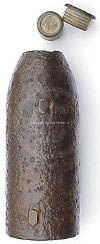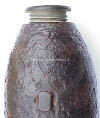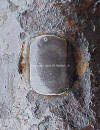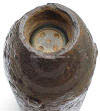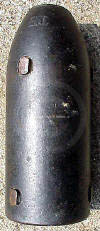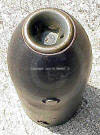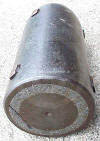Sir William George Armstrong
1810-1900
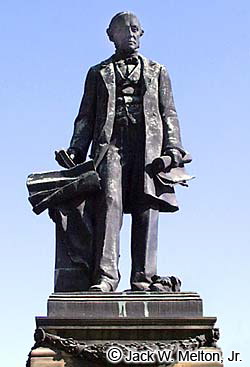
|
|
Armstrong was born in the Shieldfield area of Newcastle on the 26 November
1810. His father was the proprietor of a corn merchants business on the
Newcastle Quayside and had a strong interest in Natural History, Mathematics
and was a member of the Literary and Philosophical Society.
Young William trained to be a solicitor and although he became a partner in
a legal practice he had inherited similar interests to his father,
particularly in the field of science and engineering. Armstrong gave
knowledgeable lectures on these subjects at the Newcastle Lit and Phil and in
1842 he constructed a Hydro Electric generator. This was constructed with the
knowledge gained following the accidental discovery of a discharge of static
electricity from a colliery boiler by an engineman at a Northumberland coal
mine.
Around 1846 Armstrong's interests shifted from Hydro Electricity to
Hydraulics and he persuaded wealthy Newcastle men to back him in the
development of hydraulic cranes for Newcastle which were powered with the
assistance of the town's Whittle Dene Water Company. The scheme was such a
great success that in 1847 Armstrong gave up his legal practice to establish
the Newcastle Cranage company at Elswick which later became known as
`Armstrong's Factory' as immortalised in the `Blaydon Races'
Following the Crimean War in the 1850s Armstrong became increasingly
involved with the manufacture of armaments and his eighteen pound breach
loading gun was one of many Armstrong weapons recognized as the best in the
world. Such devices, often tested on the moors of Allendale, were ordered by
armies and navies all over the the world from Russia and Japan to the United
States. In fact Armstrong supplied both armies in the American Civil War.
From 1863 onward Armstrong became less and less involved in the day to day
running of his company affairs and began to pursue other interests. He became
particularly noted for his successful pursuits in the field of landscape
gardening. This was initially carried out in Newcastle's beautiful Jesmond
Dene most of which he owned and where he had built a house for himself and his
wife in the 1830s. Jesmond Dene was donated by Armstrong to the people of the
city of Newcastle upon Tyne in 1883.
In 1854 Mr. William George Armstrong (later Sir William George Armstrong) submitted to
the Duke of Newcastle, then Minister at War, a proposal for a new rifled field-piece, and
with the Duke's approval, Armstrong constructed a rifle in 1855. After numerous trials and
experiments his rifle was introduced into the British service. The early rifles were
composed completely of wrought iron, which was formed from long bars coiled into spiral
tubes, and then welded together by hammer-driven forging. Later he switched to a steel
tube that was reinforced with wrought iron coils. The rifles were breech-loading with a
screw mechanism that allow for a firing, with careful aim, twice in a minute or three
times a minute without aiming. From the muzzle to the trunnions the rifle is forged in one
thickness. From the breech end to the trunnions two additional layers of wrought iron are
applied. The center layer is bent around the cylinder instead of length wise for the
reason that the center layer has to sustain the thrust of the breech. At the breech is
located the breech-screw, which when turned by the handle, presses against a movable plug,
for closing the bore. The 12-pounder Armstrong rifle has a bore diameter of 3.0 inches and
is rifled with thirty-four shallow, narrow grooves. At the breech end the bore is 3.125
inches so that the projectile (coated with
lead) may enter the bore freely. The propellant charge forced the slightly oversized
lead covered projectile into the grooves. The greatest range achieved by an Armstrong
projectile is 9,175 yards, or nearly 5 1/4 miles. The muzzle-loading Armstrong rifle
had three lands and grooves with which to impart the rotary motion to an elongated projectile with soft metal studs.
This system was called the "shunt" and the grooves were of double width with a
shallow groove depth to a normal groove depth on the other side. The projectile was loaded
through the deep side into the breech of the rifle and upon ignition the projectile's
studs compressed into the shallow grooves.
Armstrong was just as much a scientist as a scholar or an engineer but was
also very much an enterprising industrialist with the advantage of an open
enquiring mind as demonstrated by the following lines once quoted by the man
himself;
"However high we climb in the pursuit of knowledge we shall still
see heights above us, and the more we extend our view, the more concious
we shall be of the immensity which lies beyond."
The later years of Armstrong's life were spent in his magnificent
parkland mansion of Cragside near Rothbury in Northumberland. Cragside was of
course the first house in the world to be lit by Hydro Electric power
This action centered the projectile in the bore
tightly, thus producing a stable flight. To see Armstrong's projectiles click
here.
|
English 3-inch Confederate Imported Armstrong Shell
This Extremely Rare studded Armstrong shell was buried by the
Confederates during their retreat in 1865. It was recovered around
twenty years ago by Chester Dawson (now deceased) in Amelia County,
Virginia. A total of seven unfired Armstrong shells, long and short
pattern types, were found by Chester. The fuzes were found in a separate hole by Tony Easter.
The shells were recovered near were the Battle of Painsville occurred.
1/4 mile up the hill from where they were found is the Pains
Crossroads. In General Henry Abbot's collection, now housed in the United
States Military Academy Museum in West Point, NY, is a similar specimen
recovered from the Richmond area by Abbot's men in 1865.
|
Armstrong Cannon information from the
Official Records
relating to the above projectile.
80 R
R--VOL XLVI, PT II
PAGE 1266-96
N. AND SE. VA., W. VA., MD., AND PA.
[CHAP. LVIII.
[Series I.
Vol. 46. Part II, Correspondence, Etc. Serial No. 96.]
SPECIAL
ORDERS, No. 55.
HDQRS. DEPT. OF NORTHERN VIRGINIA,
February 28,
1865.
XV. Maj. Gen. Bryan Grimes, Provisional
Army, C. S., is hereby
assigned to the command of Rodes' old division, Second Corps, and
will report accordingly.
By command of Gen. R. E. Lee:
W. H. TAYLOR,
Assistant Adjutant-Gen.
HDQRS. ARTILLERY, FIRST CORPS,
February 28, 1865.
[Gen. PENDLETON: ]
GEN.: I
received this morning your note directing me to turn over
four 3-inch rifles to the cavalry; but while making arrangements to
execute it, I beg to submit that it will seriously weaken my rifle
armament, already, I believe, the weakest in the army. The
10-pounder
Parrotts in my command I have condemned entirely, and have made
arrangements with the Ordnance Department to exchange them all for
24-pounder howitzers, having found it impossible to get
satisfactory
firing from them, and I hope to be rid of every one when we take
the
field. I have only six now, including two in Hardaway's battalion;
this
will leave with sixty-four smooth-bores, eighteen 3-inch rifles,
and five
Armstrong and one Whitworth in
Cabell's, Huger's, Haskell's,
Hardaway's, Stark's and Johnson's battalions the Armstrong
and
Whitworth are only temporary guns, as the ammunition for the former
is limited, and when it is gone I wish to replace them all with
smooth-bores, which will give seventy smooth-bores and eighteen
rifles
a proportion of rifles which I think you will agree with me is too
small
to be diminished. Should Owen's battalion return in place of any
other
it will diminish the proportion of rifles, as it has none, and
should
Hardaway rejoin his corps he will take away six of the eighteen
3-inch.
Many of my smooth-bores will also be howitzers of less range than
Napoleons. I do not like any rifle with our ammunition, but must
have some.
Cannot the cavalry take 12-pounder howitzers? I consider them the
best gun for their service, and would prefer them to anything were
I in
that arm. Our 3-inch have no shrapnel; their shell very defective
and
uncertain, even when they explode at all, and you know the frequent
complaint on this head and their canister is very small and
inferior. The
Yankees have shrapnel and canister with lead balls, and thus use
them
very efficiently, but our 3-inch are not their 3-inch by a great
deal. The
12-pounder howitzer is
lighter, its ammunition cheaper and more
abundant; it formidable shrapnel; its shell seldom ever fails, and
its
canister is but little inferior to that of Napoleons. Where guns
have to
protect themselves against a charge of either infantry or cavalry,
I
believe the 12-pounder howitzer
superior to the Napoleon and worth
twice its number of 3-inch rifles. Is not this gun better adapter
to the
service of cavalry than a gun whose only recommendation its has a
very
long range and one-half of whose
projectiles never burst (and when one
does burst it does not make a dozen fragments), and which is very
dangerous to our own men when fired over their heads? I have entire
forbidden their use by my battalions over our infantry.
N. AND SE. VA., W. VA., MD., AND PA.
[CHAP. LVIII. PAGE
1267-96
[Series I.
Vol. 46. Part II, Correspondence, Etc. Serial No. 96.]
I have sent in
to Col. Brown to know what he can give me to replace
the 3-inch, if you still desire the
exchange. I don't want Parrotts (would
rather have mountain howitzers,) and prefer 12-pounder howitzers to
Napoleons, of which I have enough. It will also be dangerous to
take
my guns from the lines while awaiting even the unavoidable and
especially the probable delay.
Cannot the
horse artillery be ordered to provide themselves with
12-pounder howitzers, and report to me to be directed where to
exchange them for 3-inch rifles? Please reply to me by telegraph,
care
of Gen. Longstreet, if you wish the exchange to go on as you have
directed in
you note.
Very respectfully, yours,
E. P.
ALEXANDER,
Brig.-Gen. of Artillery.
HDQRS. ARMY OF THE POTOMAC, ORDNANCE OFFICE,
May 31, 1865.
Col. GEORGE D. RUGGLES,
Assistant Adjutant-Gen.:
SIR: I have
the honor to make the following report of artillery and
small-arms received by the ordnance department, captured from and
surrendered by the enemy in the recent campaign, in operations
around
Petersburg, and against the rebel army after the evacuation. This
does
not include the heavy artillery which was collected by Gen. Abbot
and not received by any of the ordnance officers of this army:
Light
12-pounder bronze guns, U.S., 70; light 12-pounder bronze guns,
rebel,
62; 12-pounder cast-iron guns, banded, rebel 34; 3-inch
wrought-iron
PAGE 1242-97
N. AND SE. VA., W. VA., MD., AND PA.
[CHAP. LVIII.
[Series I.
Vol. 46. Part III, Correspondence, Etc. Serial No. 97.]
guns, U.S. 33;
3-inch wrought-iron guns, banded, rebel, 13;
10-pounder Parrott guns, U. S., 10; 20-pounder Parrott guns, U.S.,
2; Coehorn mortars, rebel, 1; 3-inch Whitworth guns, rebel, 1;
12-pounder howitzers, U. S., 5;
12-pounder howitzers, rebel, 3;
3.4-inch Blakely guns, 1; 3.67-inch rebel guns, banded, 1;
3.80-inch
smooth-bore guns, 2; 24-pounder howitzers, U. S., 4; 24-pounder
howitzers, rebel, 2; 24-pounder howitzers, U. S., Dahlgren, Navy,
1;
12-pounder Armstrong
guns, rifled, rebel, 5; 12-pounder iron guns,
re-enforced, rebel, 1. Total number, 251. Rifles and muskets,
21,177;
carbines, 1,293; pistols, 163. Total number small-arms, 22,633.*
Very
respectfully, your obedient servant,
F. H. PARKER,
Lieut. and
Chief Ordnance Officer, Army of the Potomac.
PAGE 72-95 N.
AND SE. VA., N. C., W. VA., MD., AND PA.
[CHAP. LVIII.
[Series I.
Vol. 46. Part I, Reports. Serial No. 95.]
No. 4.
Itineraries of
the Army of the Potomac, Sheridan's Cavalry
Command, and
the Army of the James.* cont…
Reports from the Third Brigade, Third Division.
CHAP. LVIII.]
THE RICHMOND CAMPAIGN. PAGE
85-95
[Series I.
Vol. 46. Part I, Reports. Serial No. 95.]
[March.]--Remained in camp near Hatcher's Run,
participating in the
affair of
March 25 near the Tucker house, where, after a stubborn
resistance on the part of the enemy, we succeeded in taking and
retaking the enemy's picket-line in our front.
March
29.--Broke camp, and moved with the rest of the division to the
left near the Boydton plank road.
March
31.--Made a gallant charge on the enemy's works to develop
their strength.
April
2.--Attacked and captured the enemy's picket-line where the
Boydton plank road crosses the White Oak road, and afterward
occupied his main works and advanced to Petersburg.
April 3 to
5.--Pursued the enemy.
April
6.--Came up with him at Amelia Springs.
Skirmished with him all
day, and at night succeeded in forcing him to abandon
his wagon train.

